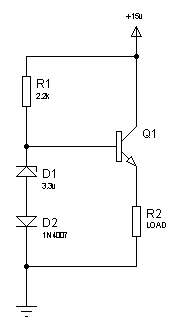david90
Advanced Member level 1
I put together a zener based ps that look like this
**broken link removed**
with Vz= 3.3V (200mw), Vs is 12-15VDC, current limit resistor = 200Ohm.
The problem that I having is when Vs= 15VDC, the output goes up to 4.5V. I have a very small load connected to the output.
Is there something wrong with my zener? I thought zener is always suppose to maintain a 3.3V voltage drop. My zener does get warm and my ammeter showed about 50mA of current.
**broken link removed**
with Vz= 3.3V (200mw), Vs is 12-15VDC, current limit resistor = 200Ohm.
The problem that I having is when Vs= 15VDC, the output goes up to 4.5V. I have a very small load connected to the output.
Is there something wrong with my zener? I thought zener is always suppose to maintain a 3.3V voltage drop. My zener does get warm and my ammeter showed about 50mA of current.
